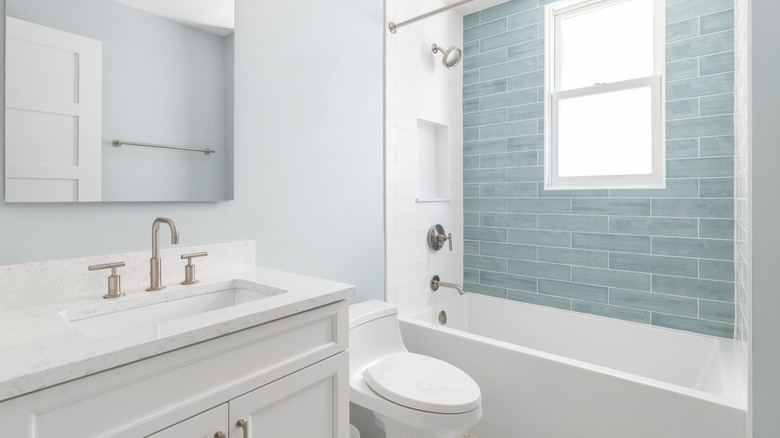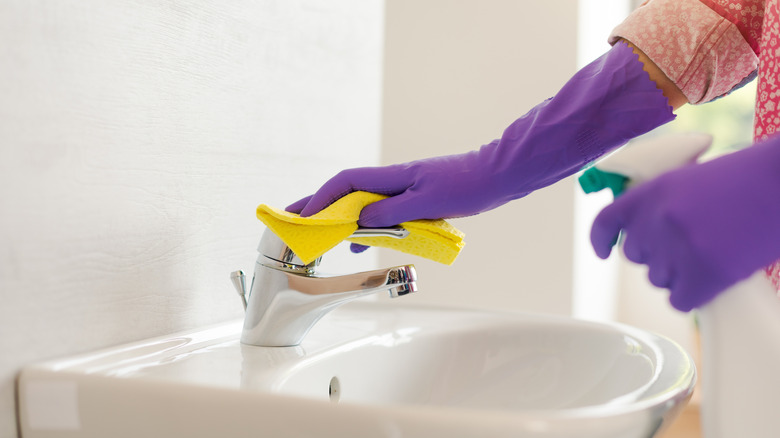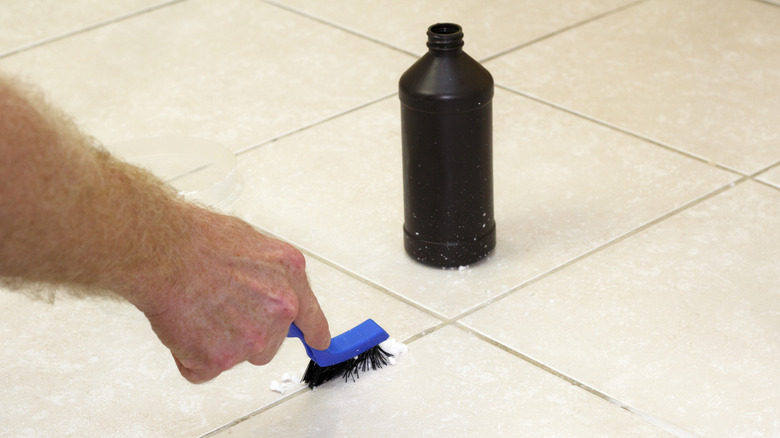You Can Clean Everything In Your Bathroom With Just One Ingredient
No one looks forward to cleaning the bathroom. It receives the most consistent traffic of all the rooms in the house, attracts plenty of dirt and germs, and serves as a breeding ground for mold and mildew due to its warm, moist environment. However, while many homeowners assume that cleaning all the dirt, grime, bacteria, and mildew requires harsh cleaning products formulated specifically for the bathroom, you can actually use a single, natural ingredient that will leave your bathroom dazzling clean: Hydrogen peroxide.
Hydrogen peroxide is a naturally occurring compound that consists of two hydrogen atoms and two oxygen atoms. It reacts easily when it comes into contact with other substances, and its second oxygen atom oxidizes, killing germs and removing stains. As a result, hydrogen peroxide can kill mold, mildew, bacteria, and viruses, making it a viable alternative to bleach for disinfecting bathroom surfaces. It actually has a fairly potent bleaching effect on stains and discolorations, too, so it works well for cleaning grout and other bathroom stains.
For more stubborn stains in the bathroom, hydrogen peroxide is often mixed with baking soda to form a paste. Baking soda is slightly abrasive, so it can scrub at stains, while the hydrogen peroxide works as a bleaching agent.
Here's the best way to clean showers, tubs, and countertops with hydrogen peroxide
Most homeowners are interested in time-saving bathroom cleaning tricks, and the good news is that hydrogen peroxide falls into that category. That's because a simple solution of 3% hydrogen peroxide and water can clean many surfaces in your bathroom. Mix one part hydrogen peroxide and one part water in an opaque or dark-colored spray bottle, so it isn't exposed to light that can degrade it.
This mixture is effective for disinfecting surfaces, such as doorknobs, countertops, faucets, bathtubs, showers, and sinks. Spray the areas, and allow the hydrogen peroxide mixture to sit for at least five minutes. You can wipe the surface with a damp sponge to rinse, but since bathroom surfaces don't come into contact with food, you can also leave them to dry without rinsing.
For shower and tub walls covered with grime and soap scum, undiluted 3% hydrogen peroxide is a better option. Instead of mixing it with water, pour the hydrogen peroxide alone into a dark-colored spray bottle. Spray your shower walls or curtain, and allow it to sit for at least 10 minutes. Scrub well before rinsing the surface clean. If your shower or tub has more stubborn stains, sprinkle the areas with baking soda to create a paste with the hydrogen peroxide. Scrub the surface, then let it sit for 30 minutes before thoroughly rinsing.
Sanitize and clean grout lines and the toilet with hydrogen peroxide
Dirty grout lines are the bane of most homeowners' existence. Fortunately, you can treat stained grout with hydrogen peroxide. Lightly stained grout often responds to a 1:1 mixture of hydrogen peroxide and water. Spray it onto the surface and let it sit for about three minutes. Use a brush to scrub the grout, and then rinse thoroughly. For more stubborn grout stains, you'll want to reach for the baking soda again. Make a paste with one part hydrogen peroxide and one part baking soda, and apply it to the grout lines, allowing it to sit for at least five minutes. Use a brush to scrub the paste in, and then rinse thoroughly.
Additionally, if you're still unsure how to clean your toilet the right way, hydrogen peroxide may be the answer. Pour a cup of 3% hydrogen peroxide into your toilet bowl, and allow it to sit for up to 30 minutes. Afterward, use your toilet brush to scrub at stains before flushing to rinse them away. If your toilet has stubborn stains, such as those from hard water, you'll usually have better luck with a hydrogen peroxide and baking soda paste. Apply it directly to the stains, let it sit for several minutes, and then use a toilet brush to scrub thoroughly. Rinse the areas by flushing the toilet when you're done.


